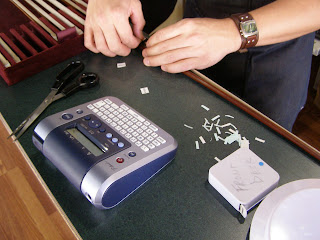In retail, keeping track of inventory is critical. Why? (A quick business 101 digression before returning to the topic). Businesses have a love-hate relationship toward inventory. They love it when inventory sells like mad to generate cash and reap profits. They hate it when inventory sales stalls while they can't pay the bills and eat losses. Thus, the reason to keep track of what sells, what doesn't sell, and even what's missing from the original count! In other words, it's called accounting.
Now, we aren't the kind of retail store that has fancy tracking systems like RFID tags or UPC bar codes. However, we do have a system that's efficient than your typical shop. All of our instruments in the shop are have a discrete "ACV" serial number inside their f-holes. All these numbers are compiled in an ever changing and expanding database as instruments come in returned, sold, or are no long with us (such as violins with a broken scroll or button).
The hardest thing to catalog in the shop has to be the bows. We've talked to other shops and they all seem to agree. Telling the difference between one bow and the next can be tough without a trained eye. Imagine the nightmare of training that new salesman to go by eye instead of a system. When I first started working at the shop, I had difficulty telling the difference between a silver and a nickel button. Can you tell the difference in the various models of frogs patterns? The convenience of a maker's stamp may help distinguish it from the others but what about the older ones with now illegible worn off stamps?
The simple solution was to use the same tagging techniques used in our ACV serial number system. However, we ran into a problem here as well. The biggest obstacle was the lack of surface area that a bow has in comparison to an instrument. The tag had to be visible to the salesman and to be of non-interference for the player's hand.
Asking around various shops, we heard of an ingenious tag solution. Apparently they drop a tiny serial number into the mortise of the frog. We thought of this option too but decided against since it's too cumbersome from a customer service standpoint. The customer would have to sit and wait as the salesman would unscrew the button, find the number in the mortise, check the database, and began his pitch.
We bounced around ideas for tags such as a thread and tag, sticker, ribbon, or a paper wrapped around the stick. Ultimately the sticker won out after a trial-and-error of wrong placements on the head, heel, thumb leather, winding, and even on the stick; all of which lead to sticky clean up situations. The next violin bow that's bought from this shop will be found on the side of the frog.
 This was our grand week long project: to catalog the entire bow collection in the shop (partly the reason why the belatedness in the entries). On the old system, we were going off of Maker's Stamps, Consignment letter descriptions, and distant memories. The labelmaker churned out small strips while Lester carefully examined each bow and entered all the information into our newly created database. This one is more comprehensive than the instrument list we have. It's also very specific data fields such as maker, stamp, balance point, setting, winding, head plate, button, consignor, owner, etc...
This was our grand week long project: to catalog the entire bow collection in the shop (partly the reason why the belatedness in the entries). On the old system, we were going off of Maker's Stamps, Consignment letter descriptions, and distant memories. The labelmaker churned out small strips while Lester carefully examined each bow and entered all the information into our newly created database. This one is more comprehensive than the instrument list we have. It's also very specific data fields such as maker, stamp, balance point, setting, winding, head plate, button, consignor, owner, etc...

The hardest thing to catalog in the shop has to be the bows. We've talked to other shops and they all seem to agree. Telling the difference between one bow and the next can be tough without a trained eye. Imagine the nightmare of training that new salesman to go by eye instead of a system. When I first started working at the shop, I had difficulty telling the difference between a silver and a nickel button. Can you tell the difference in the various models of frogs patterns? The convenience of a maker's stamp may help distinguish it from the others but what about the older ones with now illegible worn off stamps?
The simple solution was to use the same tagging techniques used in our ACV serial number system. However, we ran into a problem here as well. The biggest obstacle was the lack of surface area that a bow has in comparison to an instrument. The tag had to be visible to the salesman and to be of non-interference for the player's hand.
Asking around various shops, we heard of an ingenious tag solution. Apparently they drop a tiny serial number into the mortise of the frog. We thought of this option too but decided against since it's too cumbersome from a customer service standpoint. The customer would have to sit and wait as the salesman would unscrew the button, find the number in the mortise, check the database, and began his pitch.
We bounced around ideas for tags such as a thread and tag, sticker, ribbon, or a paper wrapped around the stick. Ultimately the sticker won out after a trial-and-error of wrong placements on the head, heel, thumb leather, winding, and even on the stick; all of which lead to sticky clean up situations. The next violin bow that's bought from this shop will be found on the side of the frog.
 This was our grand week long project: to catalog the entire bow collection in the shop (partly the reason why the belatedness in the entries). On the old system, we were going off of Maker's Stamps, Consignment letter descriptions, and distant memories. The labelmaker churned out small strips while Lester carefully examined each bow and entered all the information into our newly created database. This one is more comprehensive than the instrument list we have. It's also very specific data fields such as maker, stamp, balance point, setting, winding, head plate, button, consignor, owner, etc...
This was our grand week long project: to catalog the entire bow collection in the shop (partly the reason why the belatedness in the entries). On the old system, we were going off of Maker's Stamps, Consignment letter descriptions, and distant memories. The labelmaker churned out small strips while Lester carefully examined each bow and entered all the information into our newly created database. This one is more comprehensive than the instrument list we have. It's also very specific data fields such as maker, stamp, balance point, setting, winding, head plate, button, consignor, owner, etc...











No comments:
Post a Comment